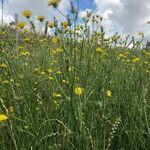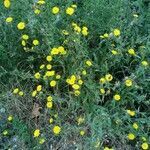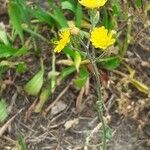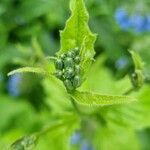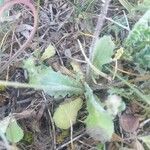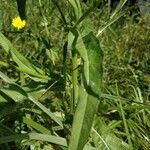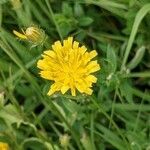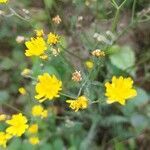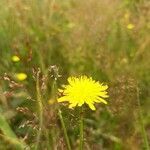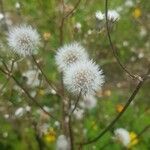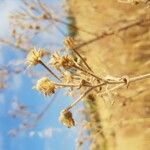Annuals, 8–80 cm (taproots shallow). Stems 1, erect (often reddish), stout (fistulose), simple or branched proximally, coarsely setose or hispid (at least distally, setae yellowish). Leaves basal and cauline; petiolate; blades oblan-ceolate, often runcinate or lyrate, 5–30 × 1–8 cm, margins dentate to pinnately lobed (terminal lobes often relatively large), apices acute to obtuse, faces finely hispid (coarsely setose along midribs; cauline leaves lanceolate, bases sagittate with acuminate lobes, margins dentate to deeply laciniate proximally). Heads 10–20, in paniculiform or cymiform arrays. Calyculi of 10–14, linear, coarsely setose bractlets 2–4 mm. Involucres cylindro-campanulate, 6–10 × 4–10 mm. Phyllaries 12–16, lanceolate, 6–7 mm, (bases strongly keeled and thickened, margins green to yellowish), apices acuminate, abaxial faces coarsely setose or hispid, adaxial with fine hairs. Florets 10–20; corollas yellow, sometimes reddish abaxially, 8–10 mm. Cypselae reddish brown, fusiform, 3–5 mm, beaked (beaks 1–2 mm), ribs 10 (rounded, spiculate near bases of beaks); pappi white (fine, soft), 4 mm. 2n = 8.
Plants to c. 1 m high, with spreading hairs on stems and leaves, long-setose on stems. Basal leaves undivided, lobed or lyrate-pinnatisect, with l:w ratio c. 4–8; margin entire or with scattered denticulations. Stem leaves few, undivided or lobed above mid-stem; base becoming auriculate, stem-clasping upwards. Capitula few or several; involucre 6–10 mm long, c. 3–4 mm diam.; outer bracts 8–10, 2–4 mm long, 0.7–1.0 mm wide, with robust, spreading, pale non-glandular hairs 1–2 mm long; inner bracts with similar indumentum, also slightly cobwebby, hardened and convex at maturity; receptacle c. 3 mm diam. Florets: ligule 5–9 mm long; style hairs dark. Achenes 4–7 mm long, tapered into a beak; body fusiform, 2.5–4.5 mm long, with ribs well-spaced, scabridulous; marginal achenes shorter. Pappus persistent, 4–5 mm long, white.
An annual herb. It grows 8-80 cm tall. It has shallow taproots. It has a single stem that is often red. The leaves are at the base and along the stem. The blades are broadly sword shaped or harp shaped. They are 5-30 cm long by 1-8 cm wide. There are teeth along the edge. There can be lobes along the stalk. There are 10-20 flower heads.
With the invol and stems strongly setose with stiff yellow bristles, and with achenes 3–5 mm, is probably not persistent with us.
